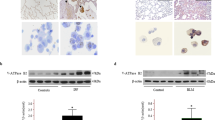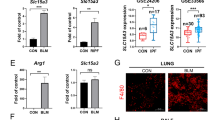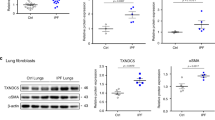Abstract
Members of the NADPH oxidase (NOX) family of enzymes, which catalyze the reduction of O2 to reactive oxygen species, have increased in number during eukaryotic evolution1,2. Seven isoforms of the NOX gene family have been identified in mammals; however, specific roles of NOX enzymes in mammalian physiology and pathophysiology have not been fully elucidated3,4. The best established physiological role of NOX enzymes is in host defense against pathogen invasion in diverse species, including plants5,6. The prototypical member of this family, NOX-2 (gp91phox), is expressed in phagocytic cells and mediates microbicidal activities7,8. Here we report a role for the NOX4 isoform in tissue repair functions of myofibroblasts and fibrogenesis. Transforming growth factor-β1 (TGF-β1) induces NOX-4 expression in lung mesenchymal cells via SMAD-3, a receptor-regulated protein that modulates gene transcription. NOX-4–dependent generation of hydrogen peroxide (H2O2) is required for TGF-β1–induced myofibroblast differentiation, extracellular matrix (ECM) production and contractility. NOX-4 is upregulated in lungs of mice subjected to noninfectious injury and in cases of human idiopathic pulmonary fibrosis (IPF). Genetic or pharmacologic targeting of NOX-4 abrogates fibrogenesis in two murine models of lung injury. These studies support a function for NOX4 in tissue fibrogenesis and provide proof of concept for therapeutic targeting of NOX-4 in recalcitrant fibrotic disorders.
This is a preview of subscription content, access via your institution
Access options
Subscribe to this journal
Receive 12 print issues and online access
$209.00 per year
only $17.42 per issue
Buy this article
- Purchase on Springer Link
- Instant access to full article PDF
Prices may be subject to local taxes which are calculated during checkout




Similar content being viewed by others
Accession codes
References
Kawahara, T., Quinn, M.T. & Lambeth, J.D. Molecular evolution of the reactive oxygen-generating NADPH oxidase (Nox/Duox) family of enzymes. BMC Evol. Biol. 7, 109 (2007).
Bedard, K., Lardy, B. & Krause, K.H. NOX family NADPH oxidases: not just in mammals. Biochimie 89, 1107–1112 (2007).
Lambeth, J.D. NOX enzymes and the biology of reactive oxygen. Nat. Rev. Immunol. 4, 181–189 (2004).
Bedard, K. & Krause, K.H. The NOX family of ROS-generating NADPH oxidases: physiology and pathophysiology. Physiol. Rev. 87, 245–313 (2007).
Geiszt, M. & Leto, T.L. The Nox family of NAD(P)H oxidases: host defense and beyond. J. Biol. Chem. 279, 51715–51718 (2004).
Levine, A., Tenhaken, R., Dixon, R. & Lamb, C. H2O2 from the oxidative burst orchestrates the plant hypersensitive disease resistance response. Cell 79, 583–593 (1994).
Ahluwalia, J. et al. The large-conductance Ca2+-activated K+ channel is essential for innate immunity. Nature 427, 853–858 (2004).
Quie, P.G., White, J.G., Holmes, B. & Good, R.A. In vitro bactericidal capacity of human polymorphonuclear leukocytes: diminished activity in chronic granulomatous disease of childhood. J. Clin. Invest. 46, 668–679 (1967).
Tomasek, J.J., Gabbiani, G., Hinz, B., Chaponnier, C. & Brown, R.A. Myofibroblasts and mechano-regulation of connective tissue remodelling. Nat. Rev. Mol. Cell Biol. 3, 349–363 (2002).
Thannickal, V.J., Toews, G.B., White, E.S., Lynch, J.P. III & Martinez, F.J. Mechanisms of pulmonary fibrosis. Annu. Rev. Med. 55, 395–417 (2004).
Hinz, B. et al. The myofibroblast: one function, multiple origins. Am. J. Pathol. 170, 1807–1816 (2007).
Desmoulière, A., Geinoz, A., Gabbiani, F. & Gabbiani, G. Transforming growth factor-β 1 induces α-smooth muscle actin expression in granulation tissue myofibroblasts and in quiescent and growing cultured fibroblasts. J. Cell Biol. 122, 103–111 (1993).
Serini, G. et al. The fibronectin domain ED-A is crucial for myofibroblastic phenotype induction by transforming growth factor-β1. J. Cell Biol. 142, 873–881 (1998).
Hinz, B., Mastrangelo, D., Iselin, C.E., Chaponnier, C. & Gabbiani, G. Mechanical tension controls granulation tissue contractile activity and myofibroblast differentiation. Am. J. Pathol. 159, 1009–1020 (2001).
Thannickal, V.J. & Fanburg, B.L. Activation of an H2O2-generating NADH oxidase in human lung fibroblasts by transforming growth factor β 1. J. Biol. Chem. 270, 30334–30338 (1995).
Thannickal, V.J. et al. Myofibroblast differentiation by transforming growth factor-β1 is dependent on cell adhesion and integrin signaling via focal adhesion kinase. J. Biol. Chem. 278, 12384–12389 (2003).
Waghray, M. et al. Hydrogen peroxide is a diffusible paracrine signal for the induction of epithelial cell death by activated myofibroblasts. FASEB J. 19, 854–856 (2005).
Cucoranu, I. et al. NAD(P)H oxidase 4 mediates transforming growth factor-β1-induced differentiation of cardiac fibroblasts into myofibroblasts. Circ. Res. 97, 900–907 (2005).
Bonniaud, P. et al. Smad3 null mice develop airspace enlargement and are resistant to TGF-β–mediated pulmonary fibrosis. J. Immunol. 173, 2099–2108 (2004).
Zhang, K., Rekhter, M.D., Gordon, D. & Phan, S.H. Myofibroblasts and their role in lung collagen gene expression during pulmonary fibrosis. A combined immunohistochemical and in situ hybridization study. Am. J. Pathol. 145, 114–125 (1994).
Thrall, R.S., Barton, R.W., D'Amato, D.A. & Sulavik, S.B. Differential cellular analysis of bronchoalveolar lavage fluid obtained at various stages during the development of bleomycin-induced pulmonary fibrosis in the rat. Am. Rev. Respir. Dis. 126, 488–492 (1982).
Vittal, R. et al. Modulation of prosurvival signaling in fibroblasts by a protein kinase inhibitor protects against fibrotic tissue injury. Am. J. Pathol. 166, 367–375 (2005).
Roberts, S.N. et al. A novel model for human interstitial lung disease: hapten-driven lung fibrosis in rodents. J. Pathol. 176, 309–318 (1995).
Thannickal, V.J. Oxygen in the evolution of complex life and the price we pay. Am. J. Respir. Cell Mol. Biol. 40, 507–510 (2009).
Sumimoto, H. Structure, regulation and evolution of Nox-family NADPH oxidases that produce reactive oxygen species. FEBS J. 275, 3249–3277 (2008).
Lambeth, J.D. Nox enzymes, ROS and chronic disease: an example of antagonistic pleiotropy. Free Radic. Biol. Med. 43, 332–347 (2007).
Raghu, G., Weycker, D., Edelsberg, J., Bradford, W.Z. & Oster, G. Incidence and prevalence of idiopathic pulmonary fibrosis. Am. J. Respir. Crit. Care Med. 174, 810–816 (2006).
Horowitz, J.C. et al. Activation of the pro-survival phosphatidylinositol 3-kinase/AKT pathway by transforming growth factor-β1 in mesenchymal cells is mediated by p38 MAPK-dependent induction of an autocrine growth factor. J. Biol. Chem. 279, 1359–1367 (2004).
Hattori, N. et al. Bleomycin-induced pulmonary fibrosis in fibrinogen-null mice. J. Clin. Invest. 106, 1341–1350 (2000).
Acknowledgements
We thank D. Lambeth, Department of Biochemistry, Emory University, for providing the rabbit polyclonal antibody to NOX-4 and A. Jesaitis, Department of Microbiology, Montana State University, for the mouse monoclonal antibody to NOX-2. We thank D. Arenberg, Department of Internal Medicine, University of Michigan, for providing primary lung mesenchymal cells from human subjects with IPF (IPF-MCs). This work was supported by grants from the US National Institutes of Health R01 HL067967 (to V.J.T.) and K08 HL081059 (to J.C.H.) and by a National Institutes of Health–sponsored Lung Tissue Research Consortium grant, N01 HR046162 (to F.J.M.).
Author information
Authors and Affiliations
Contributions
L.H. and R.V. designed, conducted and supervised experiments and contributed to manuscript preparation; T.J. and R.J. conducted experiments and contributed to primer design and analysis of gene expression data; T.R.L. contributed to mouse studies; J.C.H. contributed to RNAi studies and protein expression data; S.P. contributed to manuscript preparation; F.J.M. contributed to the studies of humans with IPF; V.J.T. conceived of, designed and supervised the project, and L.H. and V.J.T. wrote the manuscript.
Corresponding author
Supplementary information
Supplementary Text and Figures
Supplementary Figs. 1 and 2 and Supplementary Table 1 (PDF 788 kb)
Rights and permissions
About this article
Cite this article
Hecker, L., Vittal, R., Jones, T. et al. NADPH oxidase-4 mediates myofibroblast activation and fibrogenic responses to lung injury. Nat Med 15, 1077–1081 (2009). https://doi.org/10.1038/nm.2005
Received:
Accepted:
Published:
Issue Date:
DOI: https://doi.org/10.1038/nm.2005
This article is cited by
-
Traditional Chinese medicine inspired dual-drugs loaded inhalable nano-therapeutics alleviated idiopathic pulmonary fibrosis by targeting early inflammation and late fibrosis
Journal of Nanobiotechnology (2024)
-
Nintedanib-loaded exosomes from adipose-derived stem cells inhibit pulmonary fibrosis induced by bleomycin
Pediatric Research (2024)
-
The Protective Effects of Vitamin B Complex on Diclofenac Sodium-Induced Nephrotoxicity: The Role of NOX4/RhoA/ROCK
Inflammation (2024)
-
Genome-wide DNA methylation analysis of Astragalus and Danshen on the intervention of myofibroblast activation in idiopathic pulmonary fibrosis
BMC Pulmonary Medicine (2023)
-
Sohlh2 promotes pulmonary fibrosis via repression of p62/Keap1/Nrf2 mediated anti-oxidative signaling pathway
Cell Death & Disease (2023)



